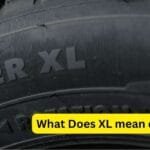Curious about what “SL” means on your car’s tires? It stands for “Standard Load,” indicating these tires are designed for typical passenger vehicle weight and pressure. Understanding this helps you choose tires based on load capacity, ensuring safe and optimal performance on the road.
Table of Contents
What does “SL” signify in the context of tires?
The “SL” on your tire stands for “Standard Load.” This SL means the tire is made to handle the weight and pressure of regular driving in cars.
Unlike tires marked “XL” (Extra Load) or “LT” (Light Truck), standard load tires don’t have extra internal reinforcements for carrying heavier loads.
What Does SL mean on a tire?
Your car’s tires are essential for a safe and smooth ride. But have you ever noticed strange codes like “SL” on them? These markings may be confusing. But they hold essential information about your tires.
One of these codes on your tire’s sidewall is “SL.” But what does it mean? Well, “SL” stands for “Standard Load.” This code indicates the tire’s load-carrying capacity under normal conditions.
Understanding what “SL” means can help you make better choices when buying tires for your car. It tells you the tire’s standard load capacity, so you know how much weight it can support.
Knowing the load capacity of tires is crucial when shopping for tires. Different vehicles require different load capacities to perform safely and efficiently. Understanding the “SL” code can help you ensure you’re getting the right tires for your car.
So, the next time you see “SL” on your tire, you’ll know it’s telling you about its standard load capacity. It’s just one of the many codes and markings that help keep your car running smoothly and safely.
Why is load capacity so crucial?
Tires are designed to carry specific weight loads; going beyond these limits can pose serious risks. Each tire’s load capacity is indicated by its load index, a number found on the sidewall and the size details.
For example, a tire with a load index of 91 can bear a maximum weight of 1,323 pounds at the recommended inflation pressure.
It’s important to note that the load index only represents the maximum weight a single tire can handle. The total weight of your vehicle, including passengers and cargo, must be evenly distributed among all four tires.
Thus exceeding the vehicle’s weight-carrying capacity, which differs from the individual tire’s load index. It remains unsafe even if the load index per tire isn’t exceeded.
When are Standard Load Tires the Right Choice?
Standard load (SL) tires are versatile and suitable for various situations. They are perfect for most everyday passenger cars, including sedans, hatchbacks, and smaller SUVs.
These tires are designed to handle typical passenger loads, ensuring a comfortable ride for drivers and passengers alike.
One of the advantages of SL tires is their impact on fuel efficiency. SL tires often offer better fuel economy because they are constructed lighter than reinforced tires like XL or LT.
Their reduced rolling resistance means they require less energy to move, resulting in improved gas mileage.
In addition to fuel efficiency, SL tires are known for providing a comfortable driving experience. Their softer sidewalls contribute to a smoother ride, enhancing comfort and handling on the road.
This quality can be especially appreciated by drivers prioritising a quieter and more pleasant driving experience.
What are the limitations of Standard Load tires?
Despite their versatility, SL tires have limitations to consider. One drawback is their reduced weight capacity compared to reinforced tires.
This makes SL tires less suitable for vehicles often carrying heavy loads, such as large SUVs, full-size trucks, or cars used for towing trailers.
Another concern with SL tires is durability. When subjected to heavy loads or used for extended periods with improper inflation, standard load tires may experience increased wear and tear.
This could lead to premature tire failure if not properly maintained.

What tire should you choose for your needs?
Choosing the right tires for your vehicle involves more than looks and cost. You also need to consider your car’s weight capacity and your usual driving patterns.
Check your owner’s manual for the recommended tire size and load rating. This is the most reliable way to determine what tires are suitable for your vehicle.
Think about how you use your car. If you often carry heavy loads, tow trailers, or go off-road, you might need tires with a higher load capacity, such as XL or LT tires.
These can handle the extra weight and stress better than standard load tires.
If you need clarification on which tires are best for you, feel free to ask for help. A trustworthy tire dealer or mechanic can offer expert guidance based on your vehicle and driving needs.
Their advice can help ensure you get the right tires for a safe and smooth ride.
Conclusion
“SL” on a tire denotes its Standard Load rating, indicating its capacity to support the typical weight of passenger vehicles. Paying attention to tire markings and selecting the appropriate load rating for your car can help maintain safety, performance, and peace of mind every time you hit the road.
FAQs
What does “SL” mean on a tire?
“SL” stands for “Standard Load,” indicating that the tire is designed to handle the weight and pressure of regular car driving.
When are Standard Load tires the right choice?
Standard Load (SL) tires are versatile and suitable for most everyday passenger cars, including sedans, hatchbacks, and smaller SUVs.
What are the limitations of Standard Load tires?
Despite their versatility, SL tires have limitations, including reduced weight capacity compared to reinforced tires like XL or LT.


